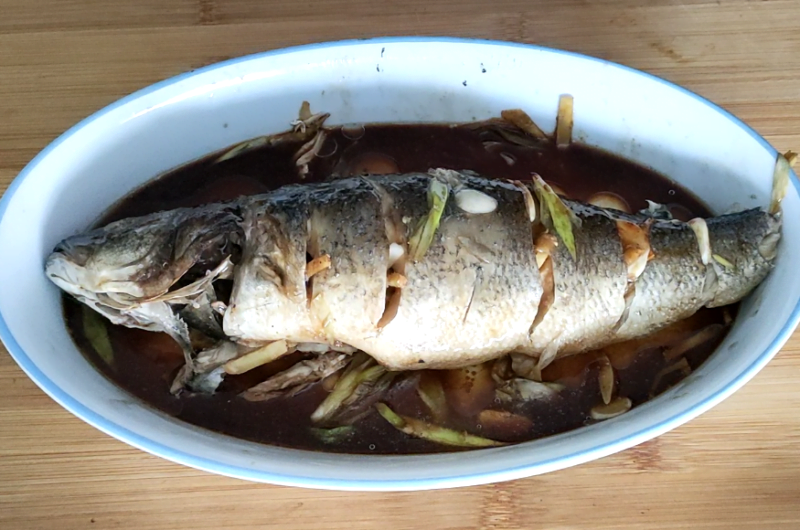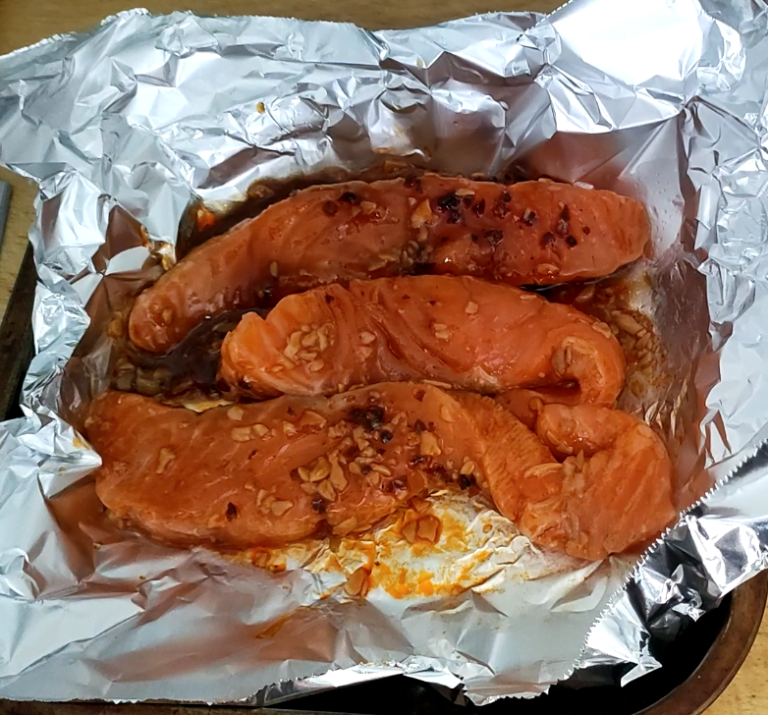Sizzle and Savor: How to Make Oven-Baked Sea Bass
In this culinary adventure, we will unravel the secrets of crafting Chinese-style oven-baked sea bass, where flavors meld in perfect harmony to create a symphony for your taste buds.
Oven-Baked Sea Bass
Course: FishDifficulty: Easy4
servings15
minutes20
minutes100
kcalIngredients
1 x sea bass
2 x tsp cooking wine
2 x tsp seasoned soy sauce
1 x Ginger
4 x garlic cloves
2 x spring onions
1 x tsp 13 spice seasoning
4 x tsp Chinkang vinegar
2 x tbs cooking oil of choice (we used olive oil)
Directions
- Take 1 fish monger prepared sea bass, make shallow cuts along the side or sides
- finely chop ginger, chop green onions(spring onions) and chop garlic
- lay a foil sheet onto a baking tray and place fish,
- Cover with cooking wine, garlic, ginger, and green onions ensure all openings are filled
- add oyster sauce, soy, vinegar spread with fingers ensuring all openings are filled
- Sprinkle over 13 spice seasoning and lightly fold foil around fish
- Place in a preheated oven 200c for 15- 20 minutes
- Pre-heat cooking oil
- remove fish from oven unwrap and pour hot oil evenly over the fish
Notes
- Delicious Chinese style oven cooked sea bass in less than an hour best served with rice enjoy!
The allure of Chinese cuisine
It is nothing short of captivating. Its vibrant flavors, intricate techniques, and rich history make it a treasure trove for culinary enthusiasts. One such gem in the vast tapestry of Chinese culinary artistry is the delectable journey of oven-baked sea bass.
Understanding the Basics
The Hero Ingredient: Sea Bass Choosing the Freshest Catch Chinese-style oven-baked sea bass begins with selecting the freshest catch available. The journey to culinary perfection starts at the fish market, where your discerning eye and keen sense of smell are your best allies. Look for clear, bright eyes and shiny scales. A fresh sea bass should have a clean, oceanic aroma, and not a fishy odor. Your choice of sea bass can make or break the dish.
The Nutritional Prowess of Sea Bass Beyond its culinary delights, sea bass offers a wealth of nutritional benefits. It’s a lean source of protein, making it an excellent choice for those seeking a healthy diet. Sea bass is also rich in omega-3 fatty acids, which promote heart health and reduce inflammation. These nutritional benefits make it a wise choice for those who prioritize wellness.
Chinese flavor profile balancing sweet and savory Chinese cuisine is renowned for its mastery of flavor balance, and oven-baked sea bass is no exception. The key to achieving that perfect balance lies in the combination of sweet and savory elements. The sweetness comes from ingredients like mirin and a hint of sugar, while the savory depth is enhanced by soy sauce and the natural umami of sea bass.
The Magic of Umami Umami, often referred to as the fifth taste, is a savory sensation that elevates the complexity of flavors in a dish. Sea bass, with its natural umami, becomes the canvas upon which Chinese flavors are painted. Understanding how to harness and enhance this umami is at the heart of crafting an exceptional oven-baked sea bass.
Essential Ingredients
The Marinade Masterclass Soy Sauce: The Salty Symphony Soy sauce is the cornerstone of Chinese cuisine, and it plays a pivotal role in our marinade. Its deep, salty notes infuse the sea bass with a rich flavor profile. Opt for high-quality soy sauce for the best results, its complexity of flavors will shine through in your dish.
Mirin: A Touch of Sweetness Mirin, a sweet rice wine, brings a delicate sweetness to the marinade. It balances the saltiness of soy sauce, creating a harmonious contrast that is quintessentially Chinese. This touch of sweetness is what sets Chinese-style oven-baked sea bass apart from other preparations.
Ginger and Garlic: The Aromatic Duo
No Chinese marinade is complete without the aromatic duo of ginger and garlic. These ingredients infuse the sea bass with a tantalizing fragrance and depth of flavor. Freshly minced garlic and finely grated ginger are the secret to achieving that perfect balance of heat and earthiness.
Sesame Oil: The Nutty Essence
Sesame oil adds a nutty essence to the marinade, elevating the overall flavor profile. Just a drizzle of this fragrant oil can make a world of difference in the final dish. It not only contributes to the taste but also imparts a delightful aroma that will waft through your kitchen as the sea bass bakes.

Fresh Herbs and Spices
Scallions: For That Refreshing Zing
Scallions, with their crisp and vibrant green color, provide a refreshing zing to the dish. They’re not only used in the marinade but also as a garnish, adding both flavor and visual appeal. The contrast of the scallion’s mild oniony flavor against the rich sea bass is a key element of this culinary masterpiece.
Star Anise: An Exotic Aroma
Star anise is a spice that carries an exotic and aromatic quality. Just one or two of these star-shaped pods in the marinade can impart a subtle licorice-like note that complements the other flavors beautifully. It’s a testament to the depth of Chinese cuisine that even the choice of spice is carefully considered.
Sichuan Peppercorns: The Numbing Sensation
If you’re seeking a more adventurous twist to your Chinese-style sea bass, consider adding Sichuan peppercorns. These tiny, reddish-brown seeds offer a unique numbing sensation along with a citrusy and slightly floral flavor. It’s a bold move, but for those who enjoy a touch of spice and intrigue, it’s worth exploring.
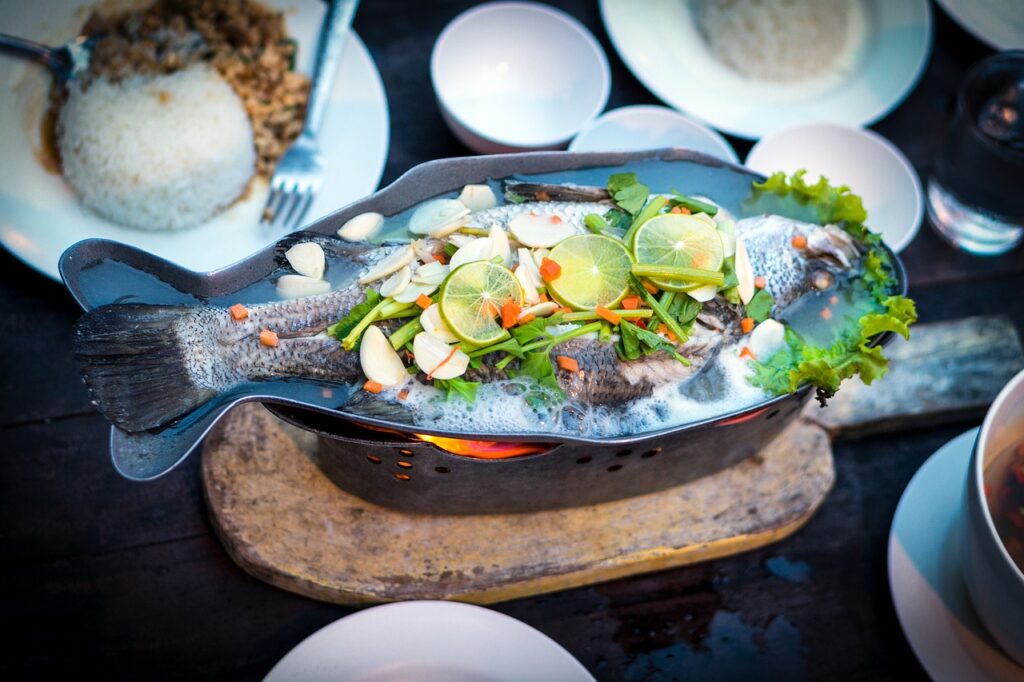
Preparing the Sea Bass
Cleaning and Gutting the Fish
A Meticulous Task
Preparing the sea bass begins with a meticulous task: cleaning and gutting the fish. This step ensures that the fish is not only visually appealing but also safe to eat. You can either ask your fishmonger to do this for you or take on the task yourself if you’re feeling adventurous.
Ensuring Freshness
The freshness of the sea bass is paramount. When cleaning, pay close attention to the gills; they should be vibrant red, a clear sign of freshness. Additionally, check the scales and skin for any signs of dullness or discoloration. A fresh sea bass will have shiny scales and clean, unbroken skin.
Score the Fish
Enhancing Flavor Absorption
Scoring the sea bass is not just for aesthetics; it serves a functional purpose. The cuts made on one or both sides of the fish allow the marinade to penetrate deeper, infusing every bite with flavor. It also helps the fish cook more evenly, ensuring a tender and succulent result.
Creating a Stunning Presentation
Beyond flavor, Chinese cuisine places great emphasis on presentation. The scored fish not only absorbs the marinade better but also transforms into a visually appealing masterpiece when baked. As the fish cooks, the skin crisps and curls, creating an eye-catching display.
Marinating the Sea Bass
The Art of Patience
Allow Time for Flavors to Meld
Patience is key when it comes to marinating sea bass(if frying). The longer you allow the fish to marinate, the more profound the flavor infusion. Ideally, marinate the sea bass for at least 30 minutes, but for truly exceptional results, extend the time to a few hours or even overnight.
Refrigeration vs. Room Temperature
While marinating, you have two options: refrigeration or room temperature. Refrigeration slows down the marination process, allowing for a longer marinating time without compromising safety. Room temperature marination, on the other hand, is quicker but can still yield outstanding results if you’re short on time.
Ensuring Even Coverage
Brushing vs. Dunking
When marinating the sea bass, it’s essential to ensure even coverage of the marinade. You can choose to brush the marinade onto the fish’s surface or, for a more intense flavor, dunk the fish into the marinade, allowing it to fully immerse. Both methods can be effective; it depends on your preference and the thickness of the fish.
Coat Every Nook and Cranny
To truly unlock the flavors, don’t forget to coat every nook and cranny of the scored fish. The cuts you made earlier will act as conduits, channeling the marinade deep into the flesh. Take your time to ensure that every inch of the sea bass is thoroughly coated.
Assembling the Flavors
Layering the Aromatics
Ginger and Garlic Infusion
The magic of Chinese-style sea bass begins with the infusion of ginger and garlic. These two aromatic powerhouses are finely minced and mixed into the marinade. As they interact with the sea bass, their flavors meld to create a fragrant and savory base that forms the foundation of this dish.
Scallions for Freshness
Scallions not only add a burst of freshness but also contribute to the dish’s aesthetics. Thinly sliced and scattered on top of the marinated sea bass, scallions infuse a mild oniony flavor while enhancing the overall visual appeal. It’s a simple yet effective touch that elevates the dish.
Balancing the Umami
Soy Sauce and Mirin Harmonization
Achieving the perfect umami balance is the heart of Chinese-style cooking. The harmonization of soy sauce and mirin is central to this endeavor. The soy sauce brings its salty depth, while mirin adds a gentle sweetness. It’s a dance of flavors that plays out on the palate, creating a symphony of tastes that is distinctly Chinese.
The Essence of Sesame Oil
Sesame oil, with its nutty essence, ties all the flavors together. Just a drizzle of this fragrant oil at the end adds a layer of complexity and a delightful aroma. It’s a reminder that in Chinese cuisine, every ingredient has a role to play, and even a small quantity can make a significant difference in the final taste.
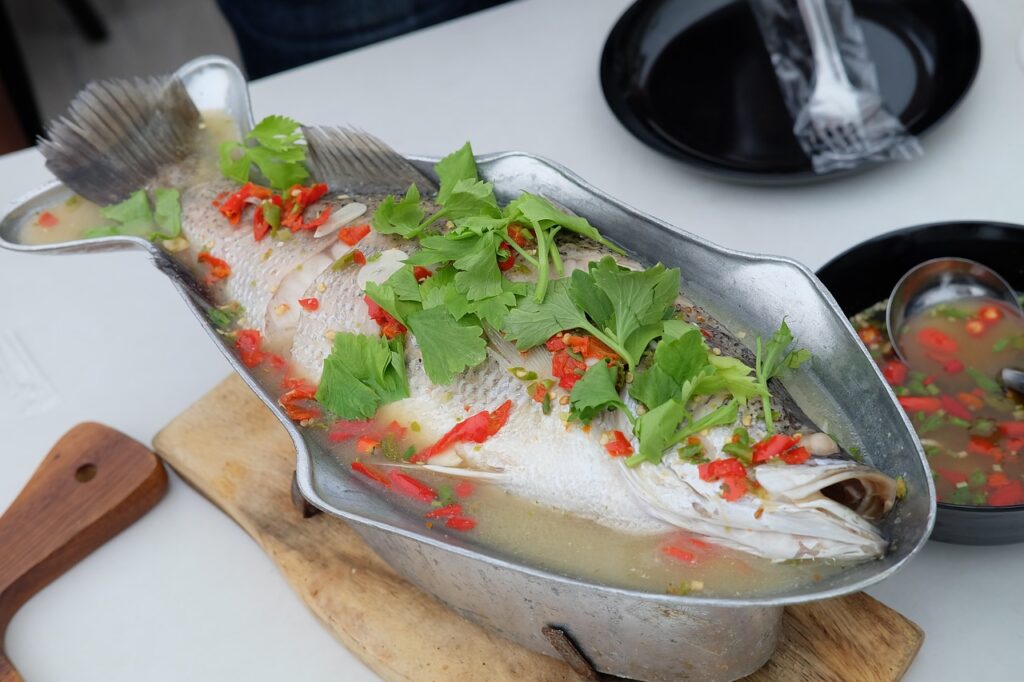
The Baking Process
The Temperature Precision
Oven Preheating
Before embarking on the baking process, ensure that your oven is preheated to the optimal temperature. This step is crucial for achieving the desired texture and flavor. Chinese-style oven-baked sea bass requires precision, and starting with a hot oven sets the stage for success.
Optimal Baking Temperature
The optimal baking temperature for sea bass is around 375°F (190°C). This temperature allows the fish to cook through evenly while preserving its moisture and tenderness. The result should be a perfectly baked sea bass with a crispy skin and tender flesh.
Timing Is Everything
Determining the Perfect Bake Time
The bake time for sea bass can vary depending on the size and thickness of the fish. As a general guideline, plan for approximately 20-25 minutes per pound (450-500 grams) of fish. However, it’s crucial to monitor the fish’s internal temperature for doneness, which should reach 145°F (63°C).
Checking for Doneness
To check if the sea bass is done, insert a meat thermometer into the thickest part of the fish. The flesh should easily flake apart and appear opaque, with a pearly white color. Be cautious not to overcook, as this can lead to dryness. When the sea bass is ready, remove it from the oven and prepare for the final steps of presentation and garnish.
Presentation and Garnish
Elevating Aesthetics
Plating with Finesse
Chinese cuisine places a strong emphasis on the visual appeal of a dish. When plating your oven-baked sea bass, consider using a beautiful serving platter or dish that complements the colors of the dish. Arrange the sea bass with care, ensuring it’s the centerpiece of the presentation.
Garnishing for Visual Appeal
Garnishes not only add flavor but also provide a pop of color and texture. Sprinkle some fresh, thinly sliced scallions on top of the sea bass for a burst of green. A few sesame seeds or a drizzle of extra sesame oil can add a touch of elegance.
Balancing Textures
Crispy Skin and Tender Flesh
One of the hallmarks of a perfectly baked sea bass is the contrast in textures. The skin should be crispy, providing a delightful crunch with each bite, while the flesh beneath should be tender and moist. This juxtaposition of textures is a testament to the precision and finesse of Chinese cuisine.
Serving Suggestions
Perfect Pairings
Steamed Jasmine Rice
To accompany your Chinese-style oven-baked sea bass, consider serving it with steamed jasmine rice. The fluffy, aromatic grains of jasmine rice are an ideal canvas to soak up the flavorful marinade and juices from the fish.
Stir-Fried Bok Choy
For a complete Chinese dining experience, stir-fried bok choy makes an excellent side dish. Its mild, slightly bitter flavor and crisp texture provide a refreshing contrast to the rich sea bass. Stir-frying with garlic and a dash of soy sauce complements the meal beautifully.
Sauces to Accompany
Soy-Based Dipping Sauce
Enhance the flavors of your sea bass by serving a simple soy-based dipping sauce on the side. Combine soy sauce, a splash of mirin, a touch of ginger, and a hint of sesame oil. This dipping sauce allows you to customize each bite to your preference, adding an extra layer of complexity.
A Dash of Chili Oil for Heat
For those who enjoy a bit of heat, consider offering a small bowl of chili oil alongside the sea bass. A drizzle of chili oil adds a spicy kick that elevates the dish to new heights. Use it sparingly at first, as a little goes a long way.
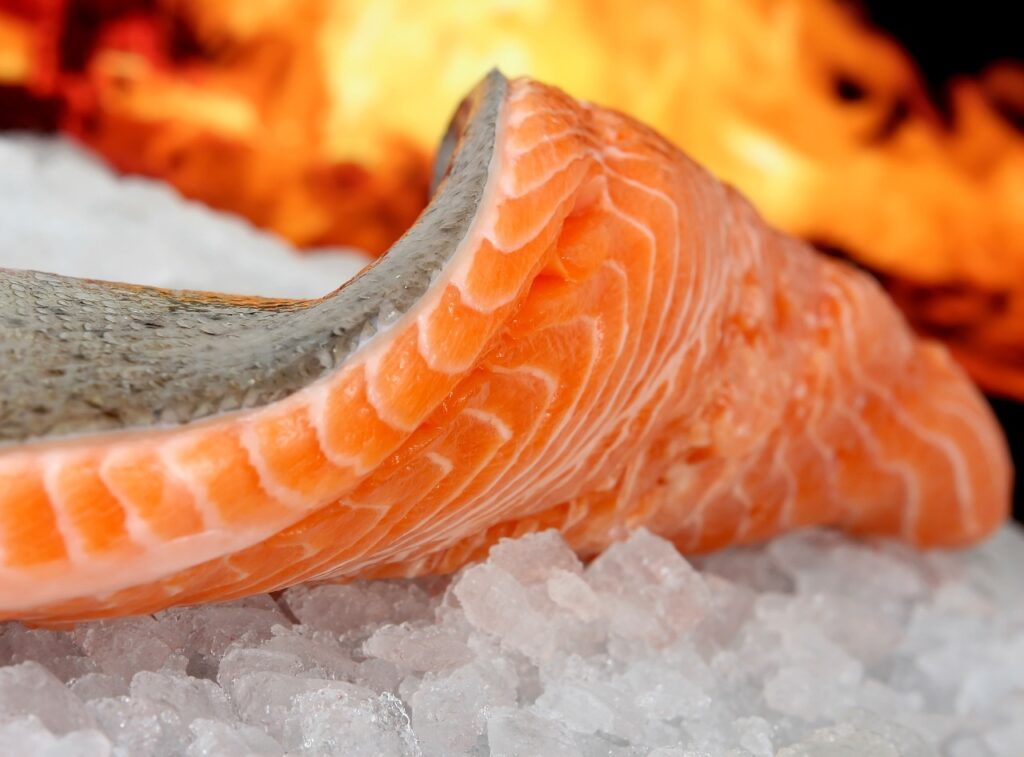
Variations and Customizations
Exploring Regional Influences
Szechuan-Style Spice
For a fiery twist on Chinese-style oven-baked sea bass, delve into the flavors of Szechuan cuisine. Add Szechuan peppercorns and dried red chilies to the marinade for a tongue-tingling experience. The numbing sensation of Szechuan peppercorns and the heat of the chilies will make your taste buds dance.
Cantonese Subtlety
On the other end of the spectrum, you can embrace the subtle and delicate flavors of Cantonese cuisine. Reduce the soy sauce in the marinade for a lighter touch. Steamed sea bass with a touch of ginger and scallions, known as “steamed fish Cantonese style,” is a classic dish that lets the natural sweetness of the sea bass shine through.
Catering to Dietary Preferences
Gluten-Free Options
To accommodate gluten-free diets, ensure that the soy sauce you use is gluten-free. Tamari or coconut aminos can be excellent substitutes for traditional soy sauce. Additionally, make sure that all other ingredients in your marinade are free from gluten-containing additives.
Vegan Alternatives
For those following a vegan or plant-based diet, you can adapt the recipe by using a tofu steak or a whole cauliflower head as the main ingredient. Marinate and bake these alternatives following the same principles to achieve a vegan-friendly Chinese-inspired dish.
Expert Tips for Success
Experiment and Adapt
Tweak the Marinade
Chinese cuisine thrives on experimentation. Feel free to tweak the marinade to suit your personal preferences. You can adjust the sweetness, saltiness, or spiciness to create a flavor profile that resonates with your palate.
Adjust Seasoning to Taste
Don’t hesitate to adjust the seasoning as you go along. Taste the marinade before applying it to the sea bass, and make any necessary adjustments. Remember that the goal is to achieve a harmonious balance of flavors that delight your taste buds.
Troubleshooting
Overcoming Common Challenges
Fish Sticking to the Tray
To prevent the sea bass from sticking to the baking tray, use parchment paper, foil, or a well-greased baking dish. The crispy skin should release easily from the surface, preserving the presentation of the fish.
Uneven Cooking
If you encounter uneven cooking, it may be due to variations in the thickness of the sea bass. To mitigate this, you can fold a piece of aluminum foil into a strip and place it under the thinner part of the fish to ensure even cooking.
Salvaging Over-Marinated Fish
Dilution with Additional Ingredients
If you find that your sea bass has been over-marinated and the flavors are too intense, you can dilute the marinade with additional ingredients such as water, vegetable broth, or a touch of citrus juice. Gradually add and taste until the desired balance is achieved.
Creative Uses for Leftover Marinade
Don’t discard leftover marinade; it’s a treasure trove of flavor. You can use it as a base for stir-fries, noodle dishes, or even as a dipping sauce for dumplings. Just be sure to cook it thoroughly to ensure food safety.
Health Benefits of Sea Bass
A Powerhouse of Nutrients
Omega-3 Fatty Acids for Heart Health
Sea bass is rich in omega-3 fatty acids, which are renowned for their heart-healthy benefits. These essential fats can help reduce the risk of heart disease, lower blood pressure, and improve overall cardiovascular health. Enjoying sea bass as part of a balanced diet can contribute to your well-being.
Rich in Essential Vitamins and Minerals
In addition to omega-3s, sea bass is a source of essential vitamins and minerals. It provides an array of B vitamins, including B12 and niacin, which are vital for energy metabolism and overall health. The fish also contains important minerals such as selenium, which has antioxidant properties, and potassium, essential for maintaining healthy blood pressure.
A Wholesome Indulgence
Low-Calorie and High-Protein Choice
For those conscious of their calorie intake, sea bass is a sensible choice. It’s relatively low
in calories compared to some other protein sources, making it an excellent option for those aiming to manage their weight while enjoying a delicious meal. Sea bass is also high in protein, which can help you feel satisfied and full.
Supporting Overall Well-Being
Beyond its nutritional benefits, sea bass can contribute to your overall well-being. The combination of omega-3 fatty acids, vitamins, and minerals supports various bodily functions, including brain health, immune function, and skin health. Incorporating sea bass into your diet can be a tasty way to nourish your body.
The Cultural Significance
A Symbol of Prosperity
Sea Bass in Chinese Culture
In Chinese culture, sea bass holds a special place as a symbol of prosperity and abundance. Its name, “鲈鱼” (lú yú), sounds similar to the word for “success” or “wealth” in Chinese. As a result, sea bass dishes are often served during celebrations and festive occasions to bring good luck and fortune.
Festive Occasions and Symbolism
During Chinese New Year and other important gatherings, whole sea bass, steamed or oven-baked, takes center stage on the dining table. Its presence is not only a culinary delight but also a way to wish for prosperity and a bountiful year ahead. This cultural significance adds an extra layer of meaning to the dish.
The Global Appeal
Sea Bass in International Cuisine
The charm of sea bass isn’t confined to Chinese cuisine alone. Its versatility and delicate flavor have made it a favorite in international kitchens. Chefs around the world have embraced sea bass, creating diverse dishes that showcase its culinary potential.
A Culinary Bridge
Sea bass bridges cultures and cuisines, bringing together flavors from different corners of the globe. Whether you’re savoring it in a Mediterranean-style dish with olive oil and herbs or enjoying it with a fusion twist, sea bass has a universal appeal that transcends borders.
Conclusion
The journey’s end is the beginning of a delectable adventure in Chinese cuisine. Chinese-style oven-baked sea bass is more than a meal; it’s a culinary masterpiece that harmonizes flavors, textures, and traditions. As you embark on this gastronomic journey, remember that the art of crafting this dish lies in patience, precision, and the careful selection of ingredients.
Your invitation to the kitchen is a passport to a world of flavors that blend sweet and savory, umami and spice, crispiness and tenderness. Chinese-style oven-baked sea bass invites you to explore the depths of your culinary creativity, adapt to your taste preferences, and celebrate the cultural richness it represents.
So, gather your ingredients, prepare your sea bass with care, and savor each bite as a tribute to the culinary magic of Chinese cuisine. Unlock the secrets of this dish, and you’ll not only enjoy a memorable meal but also experience the joy of creating a masterpiece that speaks to the heart and palate alike.


